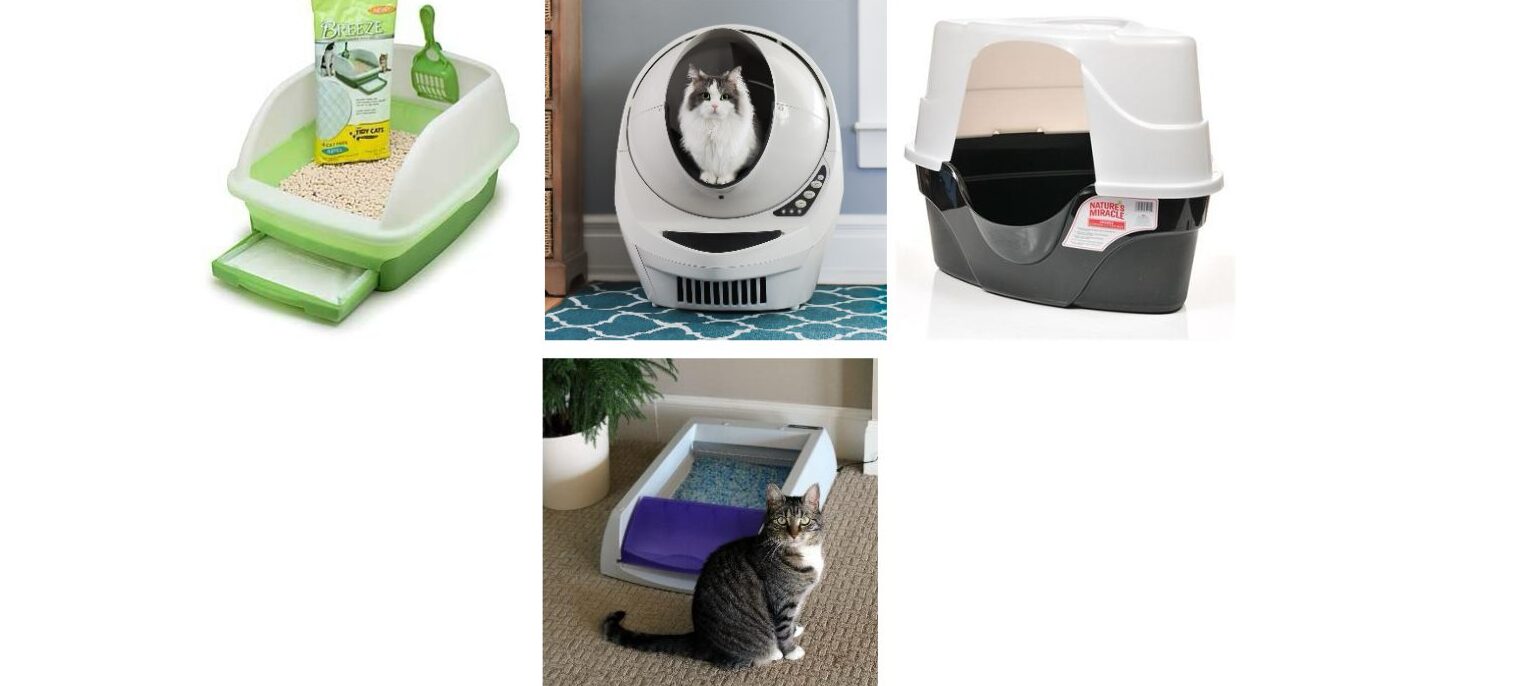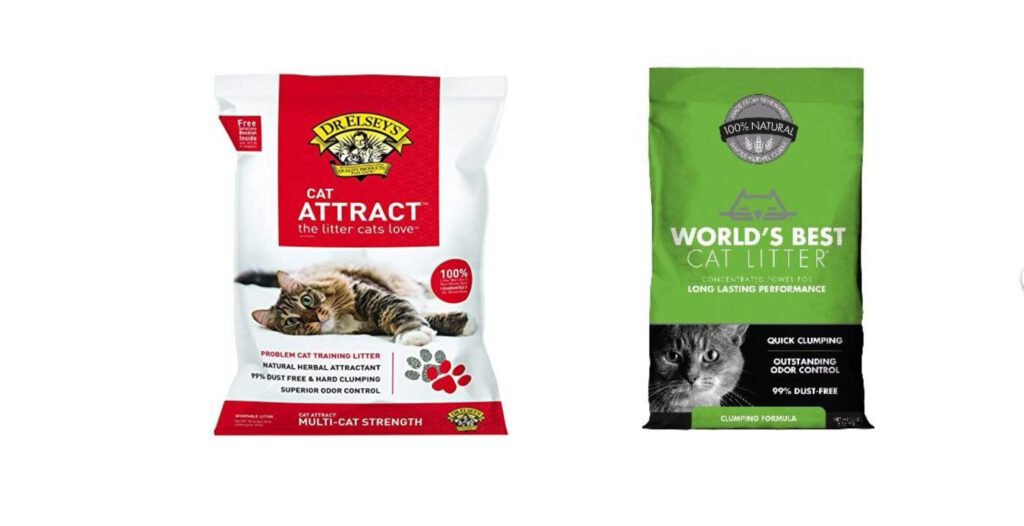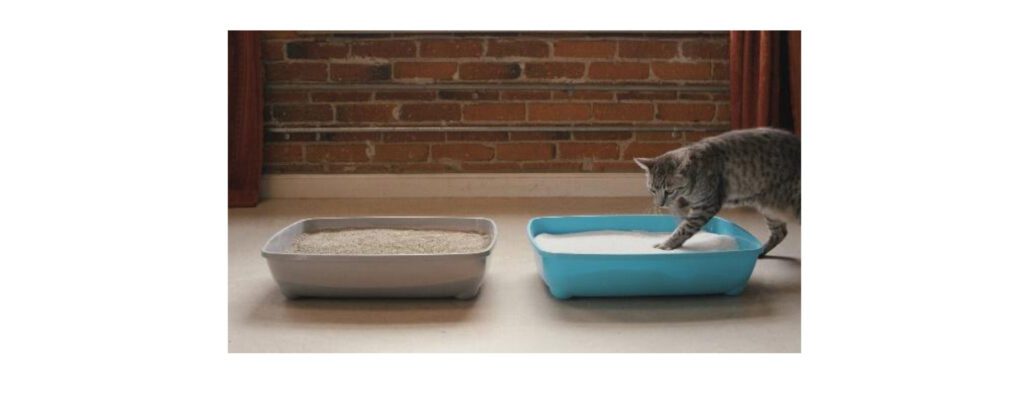Litter Box Hygiene Basics
Whether you’re the proud new owner of a kitten, or a seasoned cat owner, we all wonder from time to time if we’re using the best litter boxes, or if we even have the best litter box practices for our pets. Follow along with us this month, as we explore what every Moore County cat owner needs to know about proper litter box hygiene for their cat!

Litter Box Type: Not Belittling The Basics
The type of box you select for your cat not only impacts your home’s aesthetics, but also the level of odor in your home, and your cat’s bathroom habits. Choosing the right box is essential to keeping your pet happy and healthy, and your cleaning routine as simple and stress-free for you as possible.
There are a variety of different litter box types available on the market today. Different styles can include basic open-faced boxes, corner boxes, hooded boxes, top entry boxes, and various kinds of automatic litter boxes.
If your cat tends to be a heavy digger, a high sided or a covered litter box might do the trick to help keep more of your cat’s litter where it’s supposed to be. For pet parents with overly large cats, such as a Maine Coon cat, size considerations may be needed. XL boxes or standard flat boxes are sometimes preferred, for larger cats, to prevent your pet from feeling claustrophobic and avoiding their box. Your cat’s size, age, and temperament all have an impact on what box ultimately works best for them.
For a myriad of reasons, people sometimes elect to use an automatic litter box. If you have a cat that’s finicky about their box, a dog that likes to eat your cat’s “box presents”, if you are pregnant, or if you simply prefer ease of use, an automatic litter box can be a God-send. Most automatic litter boxes either work based on a sensor, or a timer that allows the box to self-regulate and keep itself clean in-between each use. While these boxes are often more of an up-front investment, they often save you money in the long term through litter costs.
Swapping Boxes: Don’t Pull A Fast One Over On Your Cat
Always be sure to pay attention to your cat’s needs and bathroom habits prior to making a new box selection for your cat. To introduce a new style of litter box into your home, start by placing the new box beside your old box. Let your pet get accustomed to the newly introduced box for about a week prior to removing your old box. To avoid undue stress, remember never to change your cat’s litter and box type at the same time. Many boxes also have recommendations for switch-over printed on their labels for further reference.
Litter Box Math: How Many Litter Boxes Does My Cat Need?
A commonly asked question among pet parents is “How many boxes should I have for my cat?” Veterinarians often recommend keeping one box for each cat that you own +1 box (# Cats + 1) for a healthy and happy cat.
Why is this? Keeping multiple boxes for your cat helps to cut down on bacteria, helps prevent urinary tract illnesses, prevent territorial issues in multiple cat households, and disperse the amount of waste your pet encounters when using their box. If you live on a multiple level home, keeping at least one box on each level of your home is also important to help prevent litter box problems from creeping up. All these factors help encouraging your cat to stick to using their box, versus finding alternative locations to go in your home.
How does this translate? In practice, this means that if I owned 2 cats, I would need to have 2 boxes + 1 box for a total of 3 litter boxes. For more, visit:
http://www.pethealthnetwork.com/cat-health/cat-behavior/how-many-litter-boxes-do-i-need
https://www.humanesociety.org/resources/preventing-litter-box-problems

Captivating Your Cat’s Attention: Proper Litter Box Placement
Where you place your cat’s box is also an important factor for your cat. Finding the correct placement for your cat’s box can sometimes be tricky. Check out these two helpful tips, below.
First, you’ll need to ensure that your cat’s box is always available to them. You can help do so by selecting a room that’s always open, or devoid of doors, such as a living room. If you select a place like a laundry room, you’ll need to ensure that the door doesn’t get left shut and block them off from their bathroom.
Second, you’ll need to help “keep it clean”. Just like with us, pet’s don’t like to eat where they potty. Keeping your cat’s box next to their food not only increases the risk of health issues due to fecal coliforms, but can also dissuade your cat from eating altogether. When deciding where to place your cat’s box, try finding a place away from their food or eating area.

A Quality Scoop: Selecting A Quality Litter Type
In order to keep your cat healthy, and to prevent adverse bathroom habits from cropping up, choosing the correct kind of litter for your cat is paramount. Many cats have a preference on the kind of litter they use. If you’ve recently adopted a cat, or purchased a cat from a breeder, always try to initially stick with what kind of litter your cat previously used to help prevent potential litter box problems.
When choosing your cat’s new litter, there are a variety of options that make an important every day difference for both you, and your cat. Variables such as the number of cats in your household, the coat length of your cat, amount of dust or tracking of the litter, litter type or composition, scent, and clumping vs non-clumping, all play an important role in your purchase decision.
Just like you have a favorite brand of toilet paper, your cat also has a litter that works best for them as well. While non-clumping or crystal litters might work best for long-furred cats, the same litter might not necessarily work as well for a short furred feline with a tendency not to “burry their business”.
Unless you have an exceptionally long-haired cat, clumping litter is generally preferred for overall health and cleanliness issues. Because non-clumping litter does not consolidate urine to one specific place in your pet’s box, a non-clumping litter has to be dumped and changed more frequently to keep the box fresh, and bacteria free. For most households, a quality clumping clay or clumping clay alternative litter usually does the trick.
A Note About Litter & Pet Health
We always recommend trying to look for low odor and low dust litter formulas. These two important factors play a large role in your pet’s respiratory health, epically if they are low immune, or if they are a breed with a compacted head structure (such as a Persian or a Scottish Fold). While choosing a litter based on what might be a pleasant scent for you is typically peoples first inclination, it’s important to remember that it might be less-so for your cat.
Your Cat Deserves To Be Picky: Switching The Type Of Cat Litter You Use
When making your litter selection, try narrowing down to one or two litters that you think will work best for your cat, and try one at a time until you “find your glass slipper”. When trying new litters, always be sure to offer a second box or transition your cat’s litter properly.
Once you’re ready to make your litter switch, remember to incorporate the new litter into your cat’s box gradually, like you would with a new food, so as not to disrupt your cat’s bathroom habits. If you are switching litter type/material entirely (i.e. clay to crystals), you will need to get a second box to transition with. If you make a switch, many cat litters also have switch-over recommendations listed on the back of the box or bag to help guide you in this process.

Pouring The Proper Amount: Knowing The Correct Amount Of Cat Litter To Use
Regardless of what brand your cat uses, it’s generally recommended that you use at least 3” of litter per box. Using the proper amount of litter helps ensure that your cat can properly dig and cover their “business” as needed, and so that there’s enough litter for proper absorbency. While using too little litter can prevent your pet from digging and burying, using too much litter can also harbor bad bacteria and lead to an equally uncleanly box. When filling up your cat’s box, remember to follow the 3’ rule, and never fill your cat’s litter box to more than half the height of their box.
The Down And Dirty: Litter Box Cleaning Frequency
There are two types of litter box cleans: daily spot-scoop cleaning, and litter box deep-cleans. In this segment we will discuss daily litter box maintenance, and then tackle frequency of box deep-cleaning below.
When considering how often to spot-clean your cat’s box, it’s important to remember that a typical cat uses their litter box between 3-5 times a day. Frequency of elimination, number of cats, box size, and box type all have an important role in determining how often you need to spot-scoop. If you don’t have an automatic box, then frequent (1-2 times daily) spot-scooping is highly recommended for overall pet health, and to keep your cat returning to their box vs a “clean” spot elsewhere in the house.
While spot-scooping once daily works well for most households, veterinarians recommend that households with multiple cats should consider spot-scooping at least once in the morning and once at night to maintain box cleanliness.
Why is it necessary to spot-scoop on a daily basis? Cleaning your cat’s box daily not only helps with odor caused by fecal matter and bacteria growth, but also helps to cut down on the risk of respiratory and other health issues your pet might otherwise contract from an unclean box.
The Down And Dirty: Full Box Change Frequency
The second type of box changes is a full litter box deep-clean. Frequency of a full box change all depends on the number of cats, litter box type, type & brand of litter used, how much litter you use at a time, and how often you scoop. For best health practices, within a one cat household that uses a clumping litter, it’s generally recommended that you do a deep clean of your cat’s box once every 1-2 weeks.
Why is this? If you use a standard box for your cat, you will need to take care to change your litter a bit more frequently due to dirty spots that sit during the day, or if you use an automatic box your litter typically lasts longer and can be dumped less often.
For a single cat that uses a regular non-automatic box and clumping clay litter (with you cleaning the box daily), we highly recommend dumping your litter at least every other week to keep bacteria growth down. The more cats you have in your household, the more often you will typically need to dump or change your box.

The Down And Dirty: A Step-By-Step Guide To Box Hygiene
When it’s time to fully clean your cat’s box out, follow these simple steps to ensure that you’re not just replacing the litter, but also cutting down on box bacteria and odor:
- Remove and discard all litter from your cat’s box.
- Rinse your cat’s box out with a hose, or in the bathtub with hot water. Squeeze a liberal amount of Dawn or Seventh Generation dish soap out into the bottom of the pan, and thoroughly scrub with an abrasive dish brush or scrubber. Rinse, and completely dry your box out.
- (Optional for extra odor control) Use a pet-friendly cleaning product such as a cat-specific litter box cleaner, and thoroughly spray down and wipe out your box.
- Ensure that the box is completely dry before returning fresh litter to your cat’s box.
- Best practices: Repeat this process every 1-2 weeks for one cat, and more frequently for more kitties.
Do you keep a busy schedule? Let YPCC help shorten your to-do list. Check out YPCC’s in-home Litter Box Deep Clean Service, for Moore County pet owners, today!
To read more, on changing you cat’s litter, go to: https://www.petmd.com/cat/care/evr_ct_keeping_odor_away_with_a_clean_litter_box
https://www.purina.com/articles/cat/litter/how-often-should-you-change-cat-litter
The Big Switch: Litter Box Replacement
Unless you have a disposable litter box or a litter box with a disposable pan insert, replacing your cat’s box altogether is another important part of litter box health and cleanliness.
Because most cats dig to cover their litter, scratch marks are commonly found in the bottom and on the sides of older litter boxes. Although bacteria can be kept at a minimum with proper box practices (including weekly deep cleanings), the ability to deep clean inside scratch marks and eliminate the bacteria hiding there, grows increasingly harder over time. For these reasons, veterinarian typically encourage pet owners to replace their cat’s box annually.
To read more, go to: https://cattime.com/lifestyle/42300-time-to-get-new-litter-box
Scooping Things Up Into A Conclusion
Creating a happy healthy home for your new pet starts with the basics. Knowing what to do in order to set your new pet up for success can sometimes be as simple as doing your research, and starting out on the right paw. YPCC pet care is here to help Moore County pet owners every paw-print of the way!
Photo Credits:
A. (2020). Dawn Dish Soap, Original Scent [Digital image]. Retrieved December 29, 2020, from https://www.amazon.com/Dawn-Ultra-Washing-Liquid-Original/dp/B07D85RN5K
A. (2020). Nature’s Miracle Just for Cats Litter Box Odor Destroyer, Unscented, 24-Ounce Spray [Digital image]. Retrieved December 29, 2020, from https://www.amazon.com/Natures-Miracle-Destroyer-Unscented-P-5552/dp/B001O54HUY
Avla, L. (2020). Tidy Cats Breeze Litter Box System [Digital image]. Retrieved December 29, 2020, from https://www.catfooddispensersreviews.com/tidy-cats-breeze-litter-box-system-review/
Elsey, D. (2020). Dr. Elsey’s Premium Clumping Cat Litter [Digital image]. Retrieved December 29, 2020, from https://www.amazon.com/Dr-Elseys-Attract-Problem-Training/dp/B000PKY7YA
G. (2020). Nature’s Miracle High Sided Litter Box [Digital image]. Retrieved December 29, 2020, from https://www.gakgod.com/index.php?main_page=product_info&products_id=592748
Group, A. (2020). Cat Egg Automatic Intelligent Litter Box Automatic Cleaning And Anti-splashing Oversize Cat Toilet Deodorization [Digital image]. Retrieved December 29, 2020, from https://www.aliexpress.com/i/4001098425872.html
INC, P. (2020). World’s Best Cat Litter – Clumping Formula [Digital image]. Retrieved December 29, 2020, from https://www.petsmart.com/cat/litter-and-waste-disposal/litter/worlds-best-cat-litter—clumping-formula-5178173.html
Olszewski, C. (2020). Meet Litter-Robot [Litter-Robot, The Self-Cleaning Litter Box]. Retrieved December 29, 2020, from https://www.litter-robot.com/
PetSafe ScoopFree Ultra Self-Cleaning Cat Litter Box. (2020, March 09). In 1142725229 860161616 J. Merrifield (Author). Retrieved December 29, 2020, from https://www.thesprucepets.com/petsafe-scoopfree-ultra-litter-box-review-4799167
S. (2018, July 16). How To Help Your Cat Transition To A New Litter [Digital image]. Retrieved December 31, 2020, from https://prettylitter.com/blogs/prettylitter-blog/how-to-help-your-cat-transition-to-a-new-litter







